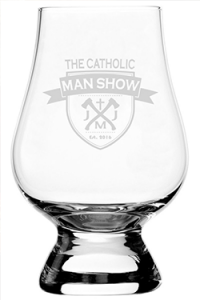Beginners Guide to Scotch Whisky
Beginners Guide to Scotch Whisky
Disclaimer: Alcohol should be consumed in moderation, which looks different for everyone. We do not give glory to God by abusing it or consuming it underage. Please exercise the virtue of temperance.
One thing that stands out for first-time listeners of The Catholic Man Show is the first segment. We open, review, and enjoy a beverage — typically a scotch. We aren’t a John Campbell by any means but over time we have come to appreciate our developing pallets needed to successfully review scotch. Here’s our quick guide for anyone interested in becoming a scotch drinker.
The spelling of Scotch whisky:
Typically, Scotch, Canadian, or Japanese whisky is spelled without an “e”. Bourbon, American, and others spell the word whiskey with an “e” but the “e” gets dropped in the land of Scotia, the plains of Saskatchewan, or in Japan.
Single Malt vs. Blended
Single malt is a malt whisky (all barley) that comes from one distillery. Contrary to popular beliefs, the “single” in single malt does not refer to one barrel, one crop of barley, or one anything except the distillery.
Blended scotch is made by combining one or more single malt whiskies (all malted barley) with one or more grain whiskies, which include barley and other grains. Blended scotch can contain 40 to 50 different malt and grain whiskies.
How are they served?
Single malts are usually served neat (in a glass, preferably a glencairn glass, with no ice). Some single malt drinkers will add a couple drops of water to the scotch claiming it opens up the whisky and releases new notes, but purists don’t buy it and refuse to do so. As the debate continues, we think it’s best to try both ways and whatever way you enjoy it is the way you should drink it.
While blended scotches are served neat as well, they are frequently served over ice, with soda water, or mixed into cocktails.
Single malts, while amazing, are not inherently “superior” to blends. As Dr. Taylor Marshall says, “Many Scotch snobs won’t even consider Johnnie Walker’s offerings, simply because they are blends. That’s a mistake.” The notion of single malt being superior is the product of decades of marketing than anything else.
Location, Location, Location
The location of a single malt distillery has a lot of influence on its flavor. Knowing this will prevent a ruined first experience with Scotch. Here’s what you should expect when buying from different regions (the label on the bottle will indicate where the whisky is distilled)
Islands:
Sea saltiness, and a heavy, aromatic smokiness and peatiness. This is not the first bottle I would buy. This tends to be an acquired taste for more of an experienced scotch drinker. The peat fires smoke the barley to produce a unique flavor that people either love or hate.
Speyside:
Fruity, nutty, with occasional sweet spiciness. You can typically find a decent bottle for in the $35 dollar range. A great group setting whisky. It’s not going to be too overpowering or heavy yet will still have unique flavors and won’t be bland. This typically makes for a good transition for a bourbon drinker
Highlands:
This is the bottle I would recommend for a first-time drinker. It’s rich, versatile accents are subtle, floral, and elegant with just a hint of peatiness.
Lowlands:
Lowlands used to be triple-distilled at one time, but these days, only Auchentoshan uses that technique for all of its production. Typically a grassy, lighter, toffee taste.
Popular vote:
Blended scotch still accounts from approximately 9 out of every 10 bottles of scotch sold worldwide. With that being said, single malt is more popular than ever. Exports increased 58% from 2010 to 2015.
Age:
Both versions of scotch are aged a minimum of 3 years but usually much longer than that. Age statements can be misleading, however. They refer to the minimum age of the youngest whisky in that particular vatting (AKA: married or blended). Which means there could be a significant amount of much older whiskies in your bottle. Additionally, age does not automatically equal quality.
Our Suggestions:
Scotch is an expensive hobby to get into, so you don’t want to invest in a bottle that you end up not liking. Here’s our list:
FIRST-TIME WHISKY DRINKER:
Glenmorangie 10 year. It won’t break the bank coming in under $40/bottle yet ‘the original’ sets a high standard for Highland whisky. Typical tasting notes include lemon, honey, malt, and a little sweet vanilla toffee.
Johnnie Walker Black. Johnnie Walker Black Label is the JW Iconic Blend, recognized as the benchmark for all other deluxe blends. Created using only Scotch Whiskies aged for a minimum of 12 years from the four corners of Scotland, Johnnie Walker Black Label has an unmistakably smooth, deep, complex character. An impressive Blended Scotch Whisky to share on any occasion, whether you’re entertaining at home with friends or on a memorable night out.
FROM BOURBON TO SCOTCH:
Balvenie DoubleWood 12 year. Bourbon is typically woody char and sweet. Speyside whiskies would be your go to if this is the case. The tasting notes include nutty, sweetness, cinnamon spiciness and a delicately proportioned layer of sherry.
Suntory Hibiki 21 year. Hibiki is one of those names in the world of Japanese whiskey that simply stands on its own. On the nose are notes of lemon, caramelized nuts, vanilla, and toffee. On the palate is a touch of oak, dark cherry, and wood spice. And with a long smokey finish, the Hibiki will certainly leave a lasting impression.
THE DABBLER:
If you have had scotch a couple times but want to continue trying new varieties, here’s a couple options for you:
Amrut Fusion – Importing peat from Scotland and mixing it with dried fruits from India — a delightful and unique mix.
Oban 14 year – A west highland malt from Oban Distillery, one of the oldest and most storied distilleries in Scotland. Tasting notes: sweet aroma filled with lemons, pears and oranges, as well as sea-salt and a light peatiness.
Lagavulin 16 year – ONe of those heavily sought-after scotches that will remain timeless. Owing its massive peat smoke to the southern Islay region, Lagavulin is a go-to pour for anyone wanting to up their scotch game. While very peaty, it offers a rich and thick palate with heavy malt and sherry coupled with a fruity sweetness that helps to balance out the heavy smoke and iodine nose.
Monkey Shoulder – Another blend of single malts—Balvenie, Kininvie, and Glenfiddich, 9 casks each, hence the name—with more overt honeyed sweetness. Balanced out by some chunky malt, with nuttiness, butterscotch, and some soft citrus notes, it’s one of the smoothest and easiest to drink.
PLAYING FOR KEEPS:
If you have listened to the podcast, this won’t come as a surprise to you.
Laphroaig 10 year – Laphroaig is known throughout Scotland as one of the country’s most medicinal malts. It’s full of character and opens up big with strong and smokey peat notes. Careful attention pulls forth various spices and licorice as well as a notable dose of salt to boot. The palate leads with seaweed, complimented with hints of vanilla ice cream and heavy oak. With each additional sip, a combination of cardamom, black pepper, and chill accumulate on the palate. While Laphroaig puts out many varieties of scotches, we can’t recommend this one enough. It is our favorite. Cheers!
Ardbeg Corryvreckan – Swirling aromas and torrents of deep, peaty, peppery taste lurk beneath the surface of this beautifully balanced dram. Like the whirlpool itself, Corryvreckan is not for the faint-hearted! Awarded The World’s Best Single Malt in 2010 by the World Whiskies Awards.
W ant the manliest Glencairn glass around? Become a Council of Man member and we will send one to you as a thank you gift!
ant the manliest Glencairn glass around? Become a Council of Man member and we will send one to you as a thank you gift!
About the Glencairn glass: The Glencairn Whisky Glass is a revolutionary whisky glass that really lets one savor the taste and complexity of fine whisky. These are great to use for any of your Single Malt Whisky’s, Irish Whiskey’s, and also your single barrel bourbons. With the tapered mouth, you are able to really smell all of the nuances the whisky has to offer. Any malt advocate will love this glass!
History Of The Glass:
Champagne, Brandy, Wine… each has its own glass. Yet whisky, the worlds most complex spirit can be found served in anything from highball tumblers to Paris goblets.
In 2001 Glencairn Crystal solved the problem of identifying the ideal glass for whisky. Designed by Raymond Davidson nearly 25 years earlier, its development involved pulling together the master blenders from the five largest whisky companies and asking them to perfect his initial design.
Today the Glencairn Glass can be found at every distillery in Scotland, Ireland, Wales as well as most in the USA.

It’s hard to come by well-informed people about this subject, however, you seem like you know what you’re talking about! Thanks
Having been a former food critic that was a well written overview to Scotch